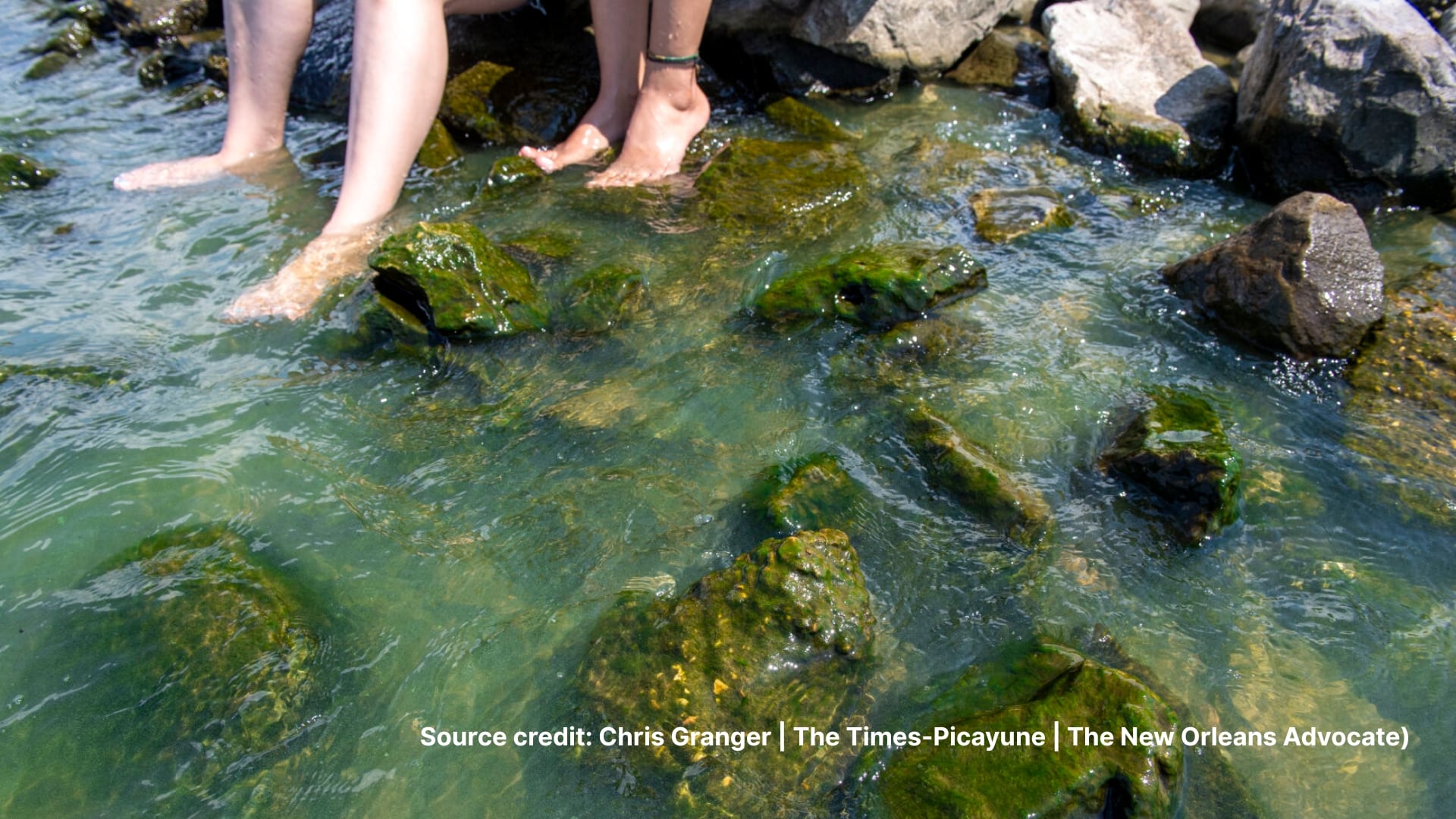What Is The Green In The Water?
Have you ever wondered what does blue-green algae look like? Blue green algae typically appears as thick, pea soup-like water or spilled green paint on water surfaces. These distinctive blooms create dense surface scums and foam that can dramatically change a lake’s appearance from crystal clear to murky green within days. Common colors include bright green, blue-green, brownish-green, and sometimes red, purple, or white variations depending on the specific cyanobacteria species present.
Visual identification is crucial for water safety since some blue green algae produce harmful toxins that affect humans and pets. Unlike harmless green algae that form stringy strands you can easily pick up, cyanobacteria blooms blend into the water creating an opaque, paint-like consistency. Learning to recognize these visual characteristics can help protect your family and animals from potentially dangerous algal toxins.
Blooms often form dense surface scums and can create murky water with reduced transparency below 2 meters. The ability to quickly identify these formations becomes especially important during warm weather when families frequent swimming beaches and pets might drink water from affected lakes.
Understanding Blue-Green Algae Appearance
Despite their name, blue green algae are actually cyanobacteria, not true algae. These ancient microorganisms are prokaryotic bacteria that contain chlorophyll and can perform photosynthesis, which explains their plant-like appearance. Unlike green algae, which are eukaryotic organisms with distinct cellular structures, cyanobacteria lack nuclei and organelles but possess specialized pigments including chlorophyll-a and phycocyanin that give them their characteristic blue-green coloration.
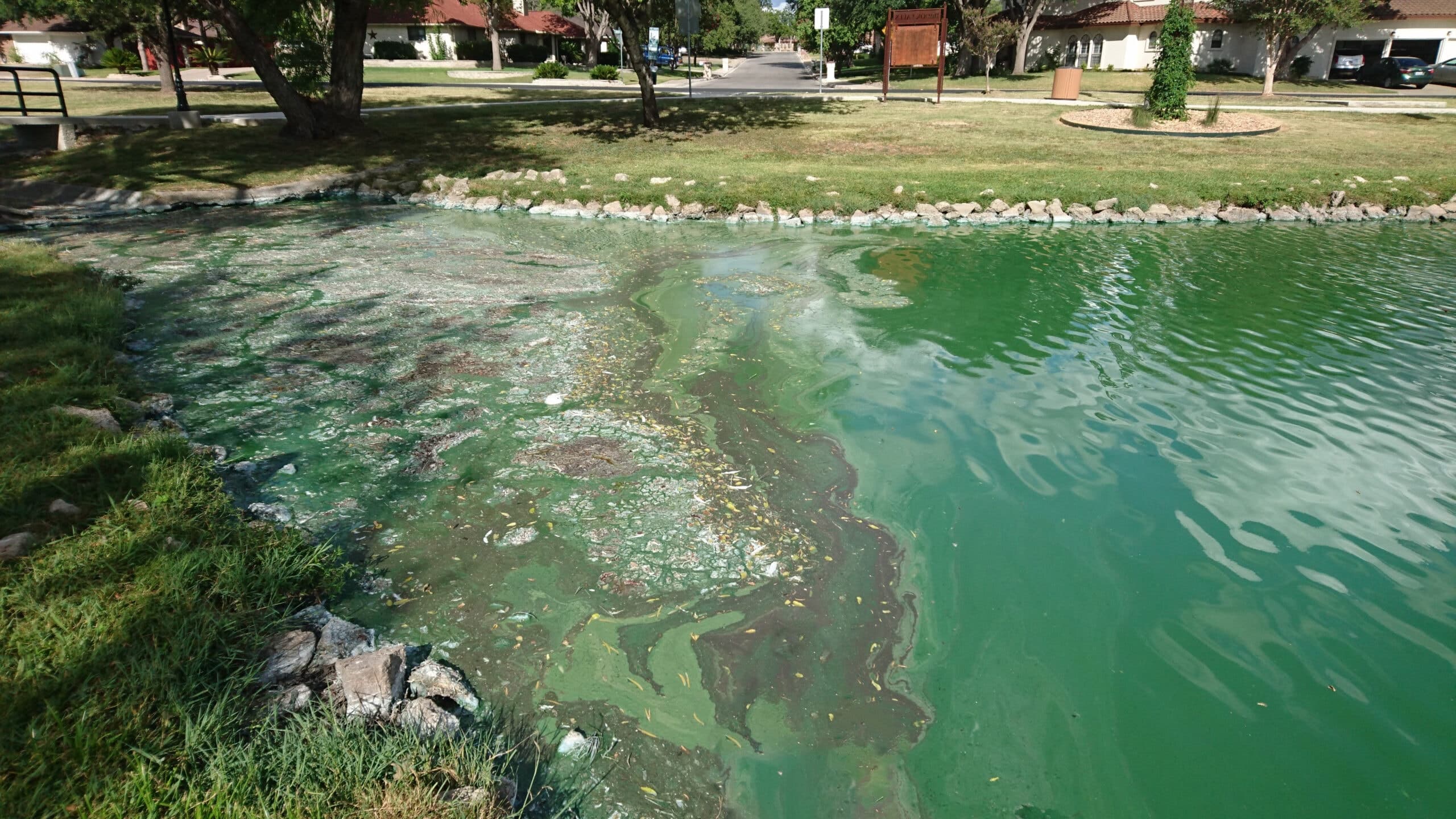
The final stage of eutrophication when cyanobacteria dominance becomes permanent in a lake as seen above. Source credit: naturallake.com
Cyanobacteria form free-floating colonies that create visible blooms when environmental conditions align perfectly. These microscopic organisms multiply rapidly under favorable circumstances, forming dense populations that can literally transform the appearance of entire water bodies overnight. The cells primarily use chlorophyll-a for photosynthesis, but accessory pigments like phycocyanin and phycoerythrin contribute to the diverse color variations observed in different bloom types.
What distinguishes cyanobacteria blooms from other aquatic growth is their behavior in water. Rather than forming distinct strands or structures that you can individually identify, blue green algae cells remain suspended throughout the water column, creating a uniform discoloration. This ultimately affects light penetration (thus reducing transparency). Hence, developing soup-like consistency that makes it impossible to see more than a few inches below the surface.
What Are the Main Visual Characteristics of Blue-Green Algae?
The most recognizable feature of blue green algae blooms is their thick, soup-like consistency that strongly resembles pea soup or spilled paint floating on the water surface. This distinctive appearance results from millions of microscopic cells suspended in dense concentrations that completely alter the water’s natural transparency.
Key identifying characteristics include:
- Dense surface scums and foam formations – Blooms create floating mats and foamy accumulations that move with wind patterns and often concentrate along shorelines
- Paint-like water discoloration – The water takes on an opaque, painted appearance where you cannot distinguish individual cells or structures with the naked eye
- Cotton candy-like masses – Some cyanobacteria species form fluffy, cotton-like aggregations that accumulate near shores or in calm bays
- Uniform green or blue-green tinting – Unlike stringy green algae, blue green algae creates an even color distribution throughout the affected water
- Complete loss of water transparency – Blooms make it impossible to see underwater features, plant life, or the lake bottom even in shallow areas
- Swampy or musty odors – Decomposing algal cells produce distinctive foul smells, particularly when blooms begin to die off
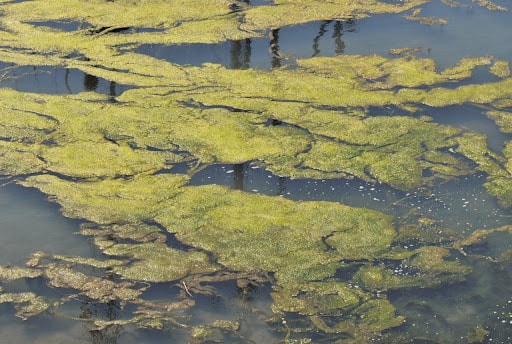
Green scum seen floating on top of the water indicating cyanobacteria presence. Source credit: lawschoollies.com
The foam and surface scums often accumulate along the downwind side of lakes, creating concentrated patches. These can be several inches thick and accumulations typically move with wind and water currents. Sometimes these cover small areas, spreading across larger sections. When algal blooms are present, the affected water loses all natural clarity and develops an artificial-looking color. This immediately signals potential danger.
How Do Environmental Conditions Affect Blue-Green Algae Appearance?
Environmental factors dramatically influence both the intensity and visual characteristics of cyanobacteria blooms. Warm temperatures above 75°F create ideal conditions for rapid cell multiplication, resulting in thicker, more visible bloom formations. During peak warm weather, especially in nutrient rich lakes, blooms can develop such density that they completely obscure underwater visibility and create striking visual contrast with surrounding clear water.
Sunny weather conditions promote the most dramatic surface scum formation. Without wind to mix the water column, cyanobacteria can regulate their buoyancy to rise to the surface where they form dense floating mats. These surface accumulations often appear as bright green or blue green patches that stand out dramatically against normal water color. During windy conditions, blooms may become less visible as cells get mixed throughout the water column, though they remain present and potentially toxic.
Wind patterns play a crucial role in concentrating bloom appearance on specific shoreline areas. Surface scums and floating mats typically accumulate on the downwind side of water bodies, creating concentrated patches that can be dramatically thick and colorful. These accumulations can shift daily based on prevailing wind direction, sometimes creating the illusion that blooms are appearing and disappearing when they’re actually just moving around the lake.
Seasonal variations show peak bloom visibility during mid-to-late summer, typically from July through early fall when water temperatures remain consistently warm. During this period, the combination of warm temperatures, increased sunlight, and lower water levels creates optimal conditions for the most visually striking cyanobacteria blooms.
What Are the Different Color Variations of Blue-Green Algae Blooms?
While the classic bright green and blue green appearances represent the most common blue green algae bloom colors, cyanobacteria can display a surprising range of color variations depending on the specific species present and environmental conditions. These color differences often indicate different types of cyanobacteria, though visual appearance alone cannot determine whether specific blooms produce toxins.
The most recognizable variations include:
Classic bright green and blue-green blooms occur in most common cyanobacteria species and create the typical “pea soup” appearance that people associate with harmful algal blooms. These colors result from chlorophyll-a combined with phycocyanin pigments that give cyanobacteria their characteristic blue-green hue.
Brownish-green or dark green variations typically develop in nutrient-heavy waters where bloom density reaches extreme levels. These darker colorations often indicate mature blooms that have been present for extended periods or waters with particularly high phosphorus concentrations that support massive algal growth.
Red, purple, or white coloration appears in certain cyanobacteria species that contain different pigment combinations. Red blooms often indicate the presence of phycoerythrin pigments, while white or cream-colored blooms may suggest different species or bloom conditions. These unusual colors can be particularly alarming since they differ dramatically from expected green appearances.
Neon green appearances create some of the most striking visual contrasts with normal water color. These intensely bright colorations typically indicate very dense, actively growing blooms during peak environmental conditions. The artificial-looking brightness often makes these blooms immediately noticeable even from considerable distances.
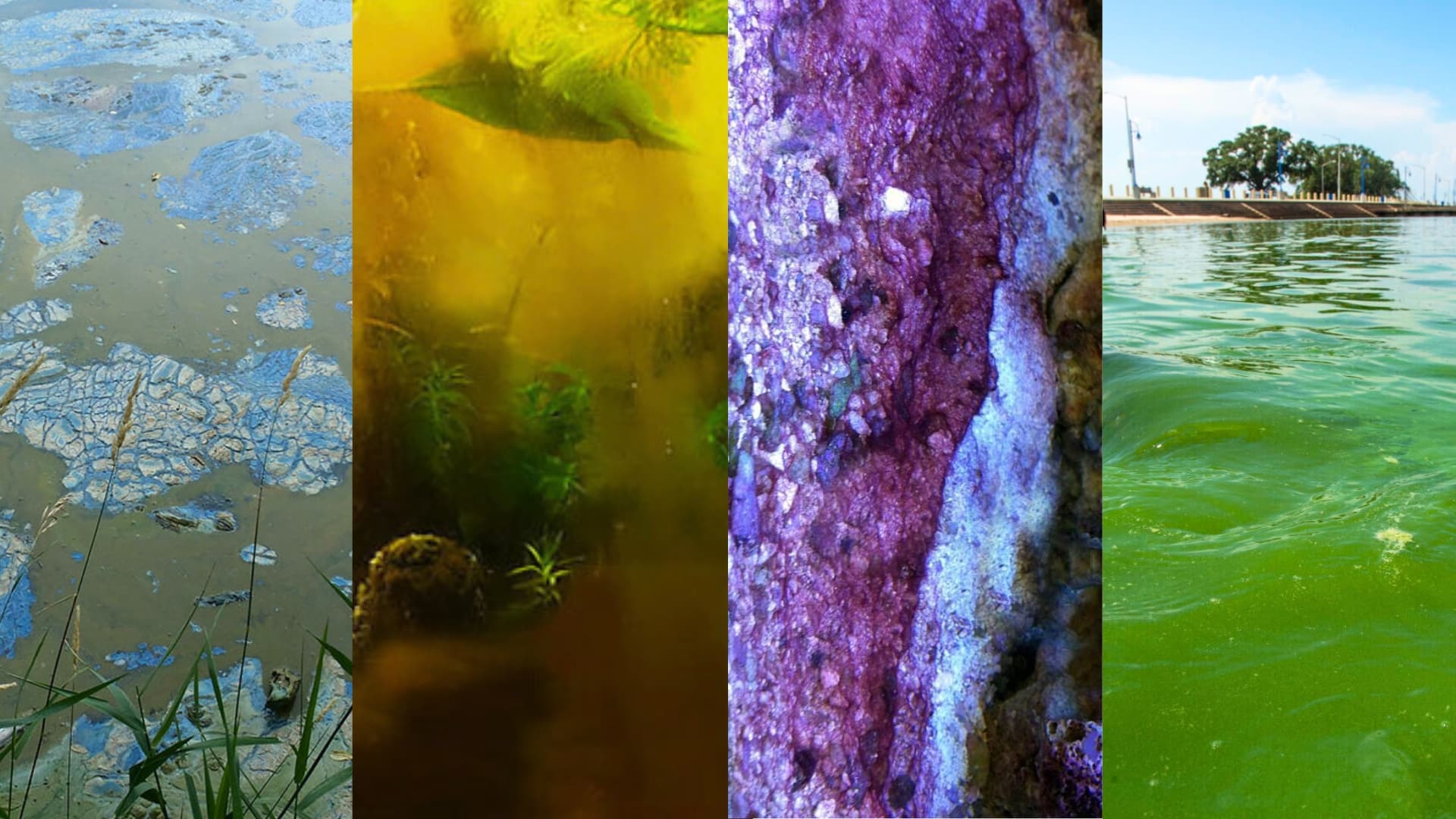
Color changes during different bloom stages provide additional identification clues. Fresh, actively growing blooms typically display brighter, more vibrant colors, while dying or decomposing blooms often shift toward brown or darker green hues. Understanding these color progressions helps identify bloom age and potential toxin production phases.
Identifying and Distinguishing Blue-Green Algae from Other Aquatic Growth
Cyanobacterial cell colours vary from chartreuse to blue-green to violet-red, depending on the ratio between phycocyanin, phycoerythrin, carotenoids and chlorophyll. This explores how different pigments (chlorophyll, phycocyanin, phycoerythrin, etc.) produce different visible colours in cyanobacteria, including red / brownish hues.
The Jar Test Method:
- Fill a clear jar with water from the suspected bloom area
- Let the jar sit undisturbed for several hours
- Green algae will typically settle to the bottom or form distinct clumps
- Blue green algae will remain suspended, maintaining water discoloration
- Cyanobacteria often create distinct separation layers with clear water on bottom
Difference Between Cyanobacteria and Harmless Green Algae
Cyanobacteria create uniform water discoloration without visible individual strands, while green algae typically form stringy, hair-like masses that you can physically separate and pick up. Green algae often feels silky or stringy to the touch, whereas blue green algae creates a slimy, paint-like consistency that doesn’t hold together when lifted.
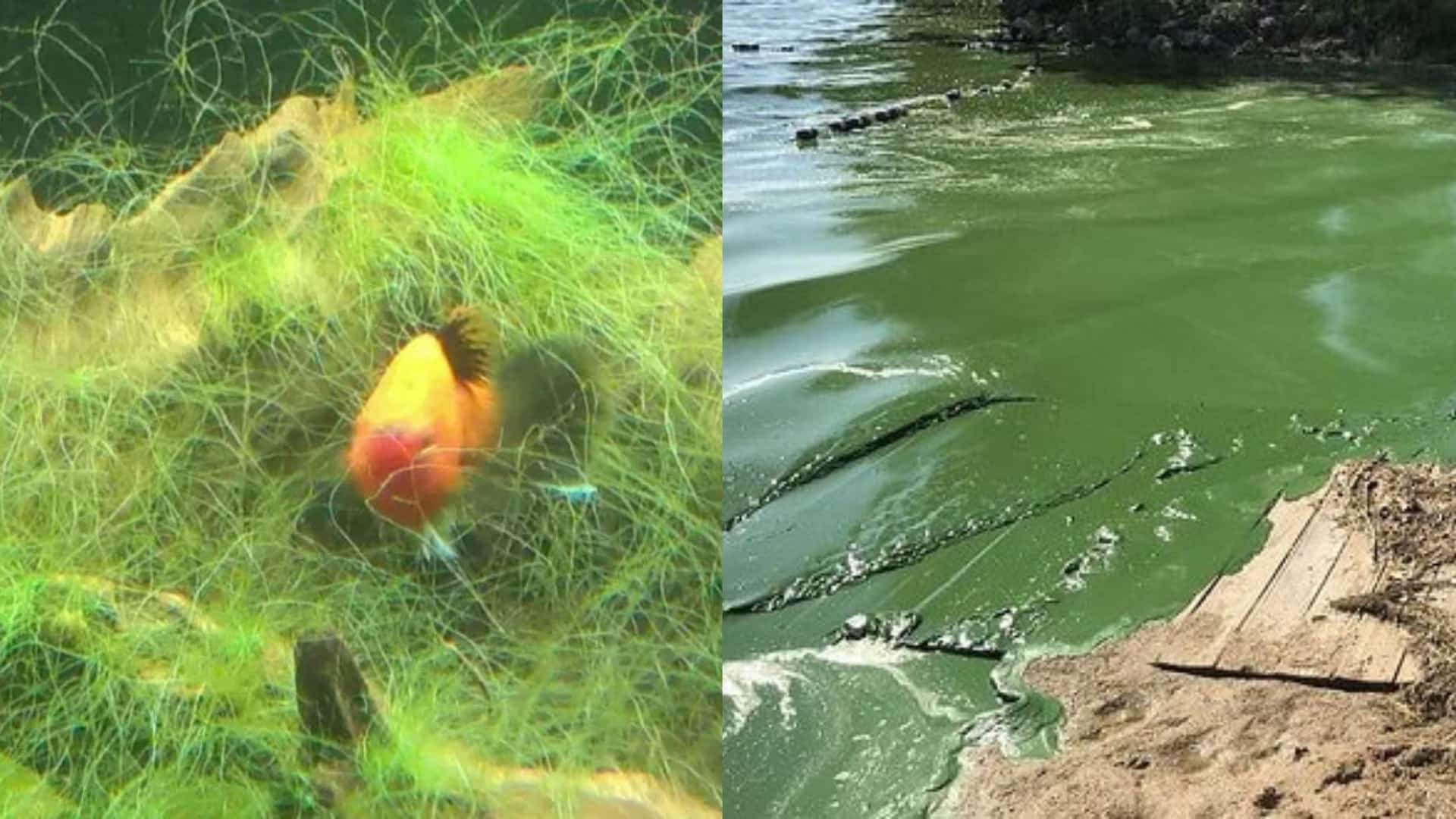
Distinguishing from rooted aquatic plants: Unlike duckweed or other aquatic plants that have visible roots, stems, or distinct leaf structures, blue green algae lacks any distinguishable plant parts. Aquatic plants typically have attachment points to the lake bottom or clear structural elements. However, cyanobacteria remain free-floating throughout the water column.
Identifying metaphyton (cotton candy-like algae): Some harmless algae species create cotton-like masses that accumulate along shorelines. These formations typically have a fluffy, cotton candy texture and can be easily separated into distinct strands when examined closely. Unlike potentially toxic blue green algae, metaphyton usually doesn’t create the uniform water discoloration or paint-like consistency characteristic of cyanobacteria blooms.
Visual clues indicating potential toxin-producing blooms: While no visual characteristics can definitively identify toxic blooms, certain features warrant extra caution. Dense surface scums, strong odors, and dramatic water discoloration suggest mature blooms that may produce toxins. Any bloom that creates complete loss of water transparency or forms thick floating mats should be treated as potentially dangerous until laboratory testing confirms safety.
Conclusion
Recognizing blue green algae requires attention to several key visual identification features. Most notably the characteristic pea soup appearance and thick surface scums that distinguish these potentially dangerous organisms from harmless aquatic growth. The paint-like consistency, uniform water discoloration, and complete loss of transparency serve as primary warning signs.
The importance of avoiding water contact when blue green algae blooms are visible cannot be overstated. Whether swimming, water skiing, or allowing pets to drink water, any contact with bloom-affected areas poses potential health risks. Even brief skin exposure can cause skin irritation. Swallowing water containing algal toxins may lead to gastrointestinal symptoms, difficulty breathing, and other serious health effects.
If you observe suspected algal blooms, particularly those showing the classic characteristics described in this guide, avoid contact and monitor cyanobacteria activity until preliminary results from water samples confirm safety. Report suspected blooms to your local department of health or environmental agency, as they often maintain monitoring programs for surface water quality and can provide guidance on current bloom conditions.
Remember that blue green algae can grow quickly under warm weather conditions. They can transform clean water into potentially hazardous conditions within just a few days. Regular visual monitoring during late summer and early fall helps identify developing blooms before they reach peak density and toxin production levels.
